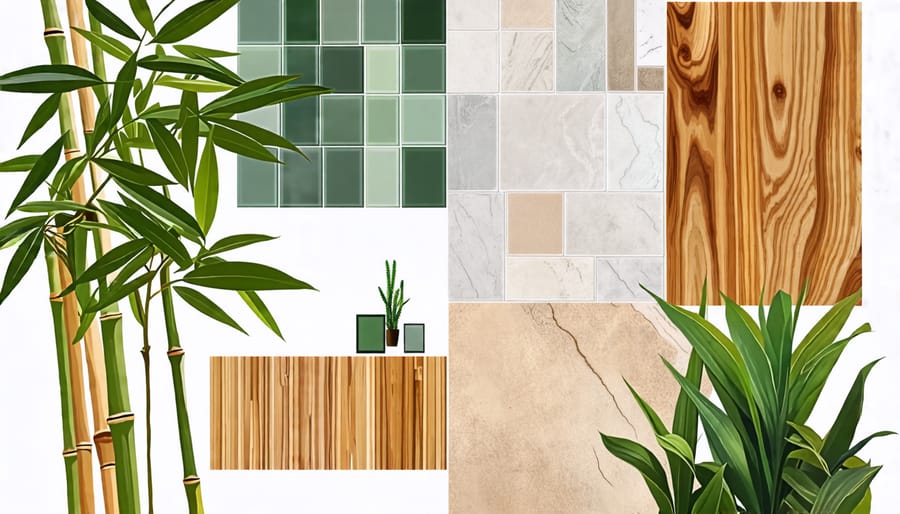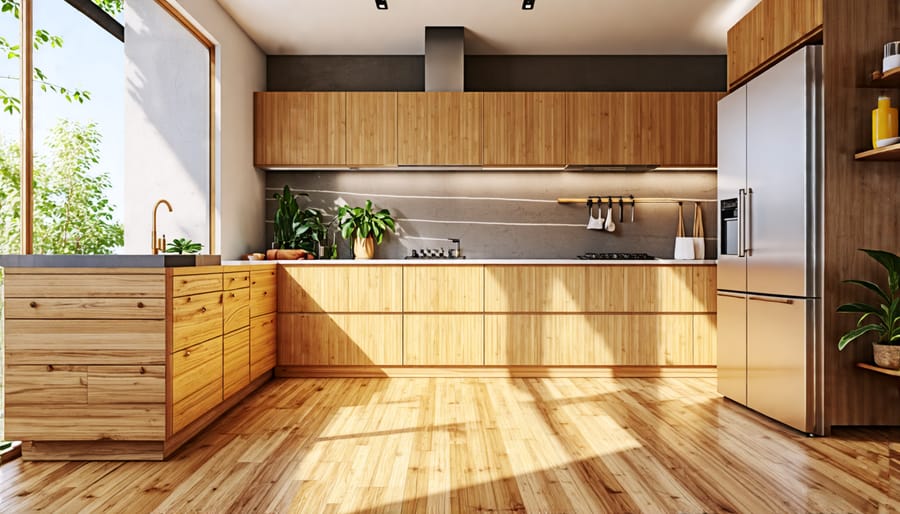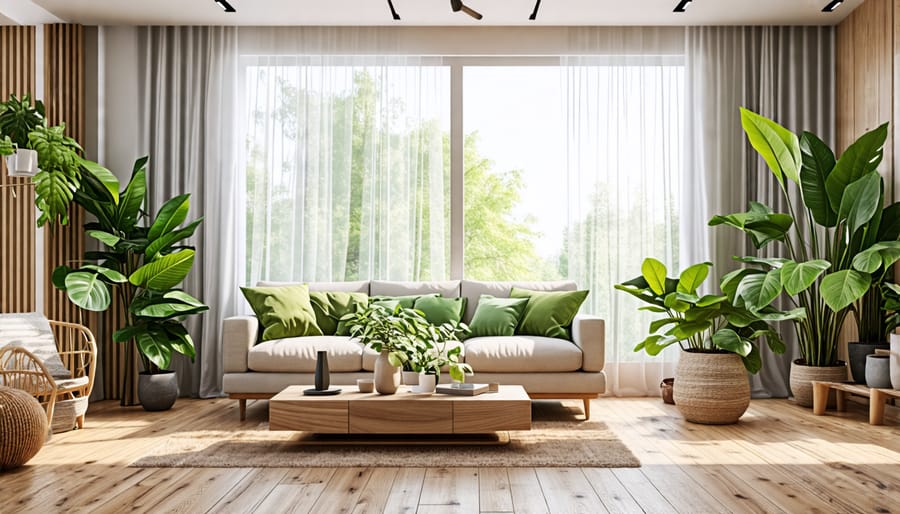Choose reclaimed wood or bamboo for flooring to enhance sustainability and add a natural warmth to your home. Opt for recycled glass countertops which are both durable and significantly reduce your environmental footprint. Install cork wall panels; they are renewable, act as natural insulators, and give any room a unique aesthetic appeal. Incorporate natural fiber rugs made from materials like jute or wool for eco-friendly decor that’s both stylish and biodegradable.
Understanding Eco-Friendly Materials

Key Characteristics
Eco-friendly materials are the superheroes of sustainable living, offering a blend of benefits that make them ideal for conscious home improvement. First, they come from renewable sources, meaning they’re from resources that nature can replenish quickly, like bamboo or cork. These materials often boast recyclability, ensuring they can either be reused or broken down without damaging the planet. Moreover, they frequently have non-toxic qualities, which means they don’t release harmful chemicals into your home, ensuring a healthier living environment for everyone. By choosing eco-friendly materials, you not only contribute to a cleaner planet but also create a safe, comfortable space for you and your loved ones. Embrace this sustainable choice and see how it transforms your home into a green haven.
Benefits of Using Eco-Friendly Materials
Using eco-friendly materials in your home projects offers numerous benefits for both the environment and your health. These materials, often sourced from sustainable resources, reduce your carbon footprint and help conserve natural ecosystems. Choosing options like reclaimed wood or bamboo also means less strain on earth’s resources. Additionally, eco-friendly options usually emit fewer volatile organic compounds (VOCs), which can improve indoor air quality and reduce pollutants in your living space. This makes your home not only healthier but also more pleasant to live in. By integrating sustainable materials, you’re also setting the stage for future savings—their durability often translates to lower maintenance costs. Whether you’re refreshing your decor or investing in eco-friendly cleaning practices, these changes can lead to a more sustainable lifestyle, aligning your home improvement endeavors with a positive environmental impact.
Popular Eco-Friendly Materials for Home Use
Recycled and Reclaimed Materials
Recycled and reclaimed materials offer a sustainable avenue for creating a unique, eco-friendly home. Imagine old barns finding new life with the use of reclaimed wood, bringing warmth and character to your interiors. This wood, weathered by time, doesn’t just look beautiful—it’s a conversation starter! Recycled glass, on the other hand, dazzles with its endless possibilities, turning discarded bottles into stunning countertops or exquisite tiles. By choosing these materials, you’re not only reducing waste but also embracing a home filled with history and sustainability. Get started with a DIY project to see the transformative magic of recycled resources in action!

Natural Materials
Bamboo, cork, and wool are standout choices in the realm of natural, eco-friendly materials. Bamboo, a rapidly renewable resource, not only brings a sleek aesthetic but is also incredibly durable, making it perfect for flooring and furniture. Meanwhile, cork, harvested from the bark of cork oak trees, is a resilient, sound-absorbing material ideal for flooring and wall coverings. It’s also naturally hypoallergenic and anti-microbial. Wool, celebrated for its insulating properties, offers warmth and a cozy feel in rugs and upholstery. These materials blend sustainability with functionality, offering numerous DIY opportunities for those looking to enhance their home’s green credentials.
Low-VOC and Non-Toxic Options
Choosing low-VOC and non-toxic materials is a smart way to enhance your home’s air quality and ensure a healthier environment. These materials emit significantly fewer chemical compounds, known as volatile organic compounds (VOCs), which can contribute to air pollution and have potential health effects. By opting for paints, sealants, and adhesives labeled as low-VOC or VOC-free, you’re reducing harmful emissions and fostering a cleaner indoor space. Consider this an investment in your well-being; it’s like giving your home a breath of fresh air. Making these choices not only supports your health but also promotes sustainable living practices that benefit the planet.
Integrating Eco-Friendly Materials into Your Home
Flooring Options
Exploring sustainable flooring options can be a rewarding journey for anyone looking to make their home more eco-friendly. Bamboo and cork are two popular choices that not only look stunning but are also renewable resources. Bamboo’s rapid growth makes it perfect for high-traffic areas like kitchens or hallways. Cork, harvested from the bark of cork oaks, provides a warm, natural feel and is ideal for bedrooms or playrooms due to its soft, cushioned surface. Reclaimed wood flooring, salvaged from old structures, offers a unique character and rich history to living spaces while preventing unnecessary deforestation. For a truly sustainable choice, consider recycled materials like glass tiles or rubber flooring made from repurposed tires. These options blend durability and eco-consciousness, allowing you to create beautiful, sustainable spaces throughout your home.
Eco-Friendly Paints and Finishes
Choosing eco-friendly paints and finishes for your home is a great step towards sustainable living. When selecting these products, look for those labeled as low-VOC (Volatile Organic Compounds) or zero-VOC. These options minimize harmful fumes, making the air in your home healthier to breathe. To ensure quality, consider products made from natural ingredients, such as plant oils, clay, or milk proteins, which are safe and biodegradable. Exploring water-based finishes can be another excellent choice as they offer durability without toxic chemicals. When tackling your next DIY project, try considering repurposed or recycled materials for an eco-conscious touch. For that perfect blend of style and sustainability, it’ll help to check product certifications or eco-labels to ensure you’re getting reliable green products. Embrace this creative opportunity to refresh your space while safeguarding the planet.
Furniture and Decor
Creating a home that reflects both style and sustainability is easier than you might think! When it comes to furnishing your space with eco-friendly materials, the options are vast and varied. A great place to start is with eco-conscious furniture. Look for pieces crafted from reclaimed wood, bamboo, or recycled metal, as they not only reduce waste but also bring a unique, story-rich element to your space. Natural fabrics like organic cotton or hemp contribute to a cozy environment while being kind to the earth. Incorporate decor items made from sustainable sources—think about glass, clay, and FSC-certified wood products. You’ll find that many of these materials are not only planet-friendly but also incredibly durable, offering a beautiful and lasting enhancement to your home. Exploring these options allows you to spruce up your space while embracing a greener lifestyle, making both your home and planet a better place.

Expert Tips for Selecting Eco-Friendly Materials
Selecting eco-friendly materials for your home improvement projects doesn’t have to be daunting. Start by prioritizing materials that are renewable, reusable, or recyclable. Look for certifications or labels like FSC for wood or GREENGUARD for low-emission products to ensure you’re picking genuinely sustainable options. Bamboo is a fantastic choice due to its rapid growth and durability, perfect for flooring or furniture. Cork, known for its resilience and insulating properties, is another great alternative for floors and walls.
When it comes to paints and finishes, opt for low or zero VOC (volatile organic compounds) products, which are not only better for the environment but also healthier for your indoor air quality. For textiles, consider organic cotton, hemp, or recycled materials, which reduce reliance on harmful pesticides and chemicals.
Upcycling and repurposing materials can add unique character to your space. Think creatively—reclaimed wood can transform into stunning shelves or tables. Visit local reclaimed material shops or online marketplaces to find hidden gems that fit your project’s aesthetic.
Remember, every small step towards sustainability counts. Whether you’re tackling a big renovation or a simple DIY project, these expert tips will guide you in making environmentally-conscious choices that reflect your style and values.
Conclusion
Embracing eco-friendly materials in your home projects is more than just a trend—it’s a meaningful choice that benefits both your living space and the planet. By opting for sustainable options, you contribute to conserving natural resources, reducing waste, and minimizing your carbon footprint. Eco-friendly materials often offer unexpected advantages, such as improved air quality and energy efficiency, which can enhance comfort and lead to significant cost savings over time.
By incorporating green materials, you create a healthier and more harmonious living environment while demonstrating a commitment to sustainability. Whether you’re starting a small DIY project or planning a major renovation, these materials provide an opportunity to enjoy the lasting benefits of mindful consumption. From reclaimed wood to recycled glass tiles, the variety of eco-friendly options is vast, making it easy to find something that resonates with your personal style and needs.
It’s the perfect time to explore sustainable home living in your space. With each choice, you make a positive impact and join a growing community focused on protecting our environment. As you plan your next project, consider how these innovative materials can transform your home into a beacon of conscious living. Let’s make a difference, one room at a time.